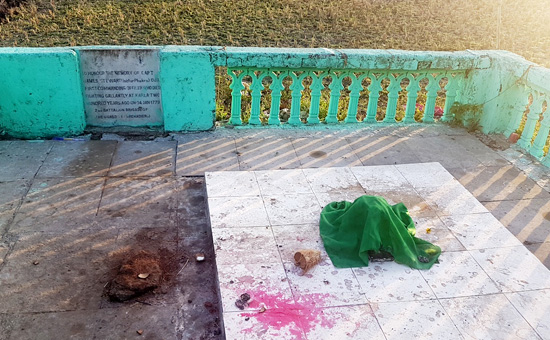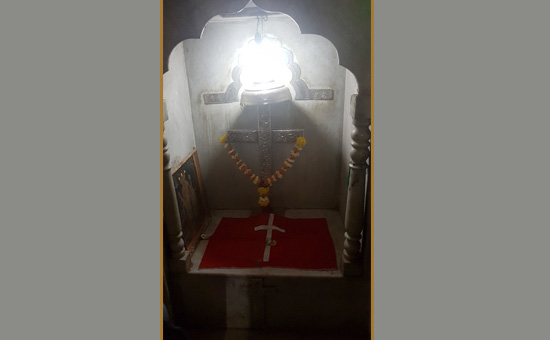- The East India
Company officer Captain James Stuart was killed during the first Anglo Maratha
war; yet, he was given the honorific epithet Phakda by the Marathas.
Indian history
for most of the 18th century is a repository of gallantry, beginning from Bajirao Peshwa’s stirring deeds, the Maratha control of Delhi and advance up to Peshawar, the recovery after the Panipat debacle and the victory over the British at the battle of Talegaon in January 1779.
In the second
half of the eighteenth century, three men were called ‘Phakda’ – a difficult to translate word that means gallant and heroic.
It was naturally reserved for men of uncommon valour. Two of these were
Marathas, but the third was British and his name comes down to us as Ishtur
Phakda.
The first of the
three Phakdas was Konher rao Trimbak Ekbote. Fighting Nizam Salabat Jung’s army led by M. Bussy in 1751, he led a valiant cavalry charge that pushed back the French trained ‘garde’ infantry and
won the day for the Peshwa. He was then awarded the title Phakda with other
honours including a palanquin.
The second Phakda was Manaji Scindia, the grandson of Sabaji Scindia who fought at Lahore, and was after Panipat was recommended to head the House of the Scindias by Raghunath rao. Eventually, Madhav rao Peshwa intervened and handed over this role to Mahadji. Consequently, Manaji remained loyal to Raghunath rao, but changed sides within the Maratha polity now and then. His fierce and powerful appearance with a body marked with scars from several battles, his fearless demeanour and bravery on the battlefield made him the second ‘Phakda’ of the Marathas.
The third was altogether a different and interesting story. It was Captain James Stuart (also spelt Stewart) of the East India Company…and Stuart became Ishtur in the Maratha vocabulary. In the aftermath of Narayan rao Peshwa’s assassination in 1773, a civil war broke out in the Maratha Government. The newly appointed Peshwa Raghunath rao was implicated in the late Narayan rao’s assassination and a ministerial party principally (and consistently) led by Nana Phadnis – who opposed Raghunath rao’s appointment – stood between Raghunath rao and the musnad.
The year 1774 saw the English take advantage of this civil war by grabbing the island of Salsette adjacent to Mumbai. With Maratha forces sent to capture Raghunath rao, he took refuge in Malwa with Scindia and Holkar – who promised to bring him to Pune. However, during his journey to Pune, Raghunath rao escaped and reached Gujarat - where he took the help of the English. This
triggered off the first Anglo Maratha war, largely the ambitious
brainchild of the Mumbai Governor Hornby.
An initial treaty between the Marathas and the English in 1776 failed, and soon hostilities commenced once again. A reluctant Warren Hastings – who was the Governor General – entered the fray and sent an army overland from Bengal. British spies in Pune sent reports that some of the Maratha chiefs – principally Holkar, Moroba Phadnis and Bajaba Purandare would come over with their adherents to the English side if Raghunath rao – also known as Raghoba dada - came up the Bore ghat towards Pune with an army. They would support his claim to be appointed as the child Peshwa Sawai Madhav rao’s Regent.
Getting wind of
the conspiracy, Nana imprisoned his cousin Moroba. Mahadji Scindia and Tukoji
Holkar were summoned to Pune. The Patwardhans and Hari pant Phadke and an artillery force under Bhivrao Panse were also asked to get ready for any aggression. The British sanctioned an expedition towards Pune under a council of three including the Commander in Chief Lt. Col. Egerton -– who had some experience of war in Germany, the veteran John Mr. Carnac and Thomas Mostyn. Lt. Col. Cockburn, Lt. Col. Cay, Lt. Col. Hartley and Captain James Stuart were some of the British officers in the expedition. John Carnac who had won a famous victory over Shah Alam II in 1761 was also part of this expedition. Of these, Stuart was already known to the Marathas for his military abilities.
The Bombay army comprising
about 3900 men reached Panvel and from there with their guns, landed at the
foot of the Bore ghat in December 1778. Here, the committee began to look for
ways to climb the ghat with its rudimentary path with their guns. James Stuart
was sent ahead with the van to occupy the heights of the ghat which he did on
22 November 1778 with six companies of sepoys and some light guns. He then sent
messages to the army to make haste.
The choice before the Committee was to carry the guns up using labourers or make a path to go up the ghats. Precious time was spent in this while Stuart fended off attacks from his position on the top of the hill. By the end of December, the British had climbed the top of the ghat and begun the descent to the plains towards Pune. Here, Stuart, with his vigorous manoeuvres pushed back the Maratha armies trying to prevent his onward march. Between Christmas and New Year, Marathas launched attacks on the British positions using their rockets and Bhivrao Panse’s artillery with seven guns. Stuart repelled the first two attacks, however, the third attack killed Lt. Col Cay when a rocket struck his loin.
Breaking out of
Khandala at the top of Bore ghat, on 4 January 1779 the British army had
reached the village of Karla and camped next to a grove and a small lake. The
camp was not far from the fort of Lohagad
which was an important Maratha post overlooking the ghats. A steady fire from
the fort was kept up at the English camp, making it difficult for the British
to move out. Bhivrao Panse, the artillery chief had a firangi gunner
named Noronha who was able to pin down the British.
Meanwhile, Nana Phadnis had opened his treasury in Pune and rewarded all the chiefs with sufficient funds to fight the British forces. English papers speak of Raghoba’s confidence that Holkar and perhaps Scindia would break ranks and come over to his side. This was avoided when Nana opened his treasury. The English council was divided. Lt. Col. Cay was killed and Mostyn, their chief strategist, had fallen ill and returned to Mumbai. He died in Bombay on 1st January 1779. With his
departure, a person who knew Pune and the Maratha polity well departed from the
scene. Lt. Col. Egerton declared he was ill and resigned his command to Cockburn.
That left Stuart and Hartley as the two most energetic of the military
officers.
 The place where body of Ishtur Phakda was buried has a memorial to a 'Phakkad baba' today.
The place where body of Ishtur Phakda was buried has a memorial to a 'Phakkad baba' today.
On 4th January 1779, the Maratha artillery began fire from sunrise and continued the fire until afternoon. Maratha accounts state that Stuart climbed a tree to survey the enemy’s position. Well built, his was a figure that was instantly recognisable. Hari pant Phadke lined up his gunners and fired. A cannon ball hit Stuart on the back of his shoulder at this time and he died a couple of hours later. A memorial was raised at the spot where he died. Stuart’s death along with Cay’s, deprived the British of two of their most energetic officers. Hartley took over the command of the Grenadiers. Stuart’s death raised the Maratha morale. They had fought Stuart for nearly a
month since he occupied the heights of Khandala. Now, recognising his valour
they collectively began to call him by the honorific epithet Phakda.
An anecdote of the time says that the five-year-old Peshwa at Pune asked the cause for worry. His advisors said they feared the English would not give way. To this, the young child rose and picked up a sword, exclaiming, ‘The Englishman is dead!’ By evening the news of Stuart’s death reached Pune and the first hopes of a victory rose in the Peshwa’s court.
Less than ten days after Stuart’s death, the Maratha army not only attacked British positions from the flank and cut off their retreat by positioning an army in the Konkan, but burnt villages in the vicinity depriving the British of all provisions. The trio of Nana Phadnis, Mahadji and Holkar moved to the village of Talegaon, which was also burnt. The Maratha army surrounded the British rendering them completely helpless. They sent out emissaries seeking a treaty and after taking two hostages, the
Marathas forced them to sign a most humiliating surrender. To avoid the capture of their guns, the British dumped them in a lake at Talegaon – where they might still be.
The surrender at
Wadgaon stung the British severely and resulted in the removal of Egerton and
the veteran Carnac from Company service. Carnac had issued the order to retreat
and was held responsible for the loss. After the treaty, Raghoba dada was
surrendered to Mahadji - and not Nana - who sent him to Malwa under an armed escort.
 The head of Ishtur Phakda is said to be buried in a police station at Wadgaon built in 1889.
The head of Ishtur Phakda is said to be buried in a police station at Wadgaon built in 1889.
Raghoba once again escaped from Mahadji’s escort and made his way to the British town of Surat. The agreement at the battle of Talegaon was then repudiated by the British and once again, war commenced. It finally ended in 1782 after Mahadji negotiated the peace with Warren Hastings and the cause of Raghoba dada was given up.
To this day, Ishtur Phakda is remembered for his gallantry in battle by a generous foe. In a strange twist, the British officer – who died in Karla – has two more graves dedicated to him in Vadgaon, and these are in all probability mythical, built as they were a hundred years later. Even stranger is the local tradition to pray to ‘Phakkad baba’ and the Ishtur Phakda ‘deity’ in the police station. However strange these beliefs may seem, it is said one cannot argue with faith, and this is perhaps an apt example to prove the adage.
To read all articles by Author
All pictures by Author.
References
1 Ishtur Phakda – by Charles Kincaid
2 First Anglo Maratha war – by M. R. Kantak.
3 Personal
notes.
Also read
1 How
a Maratha general defeated the British
2 Pictures of Lohagadh Fort